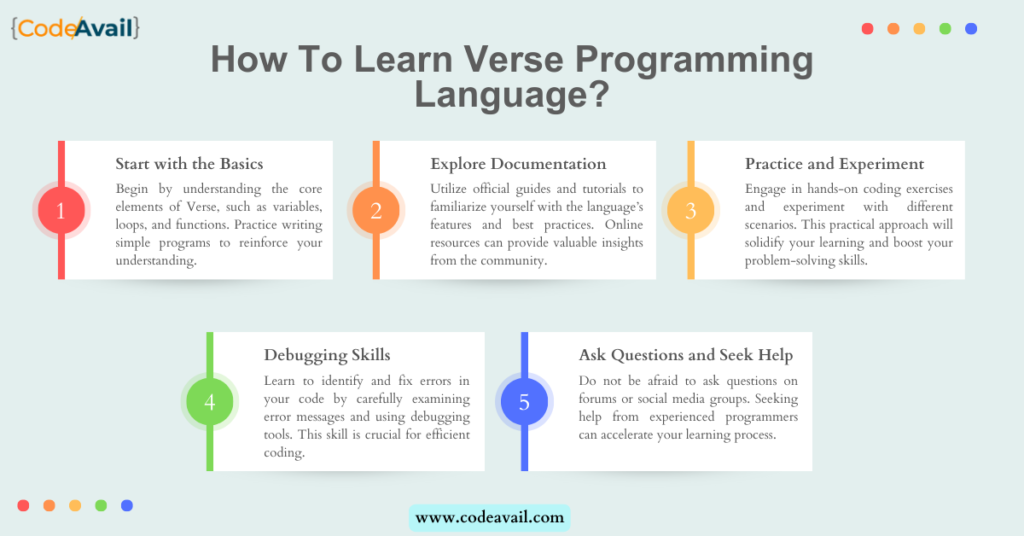Verse programming language is a modern, open-source, general-purpose programming language that was first introduced in 2017. It is designed to be simple, expressive, and efficient, focusing on making programming more accessible to a wider range of users.
In addition, what makes Verse unique and interesting is its innovative approach to programming, which includes a new syntax and type system, as well as a range of powerful features that make it ideal for developing high-performance, reliable, and scalable software.
In this blog, we will discuss the various concepts of verse programming language, such as history of Verse, its key features, syntax, and semantics. Moreover, we will discuss its applications and compares it to other programming languages.
At last, you will have a better understanding of what makes Verse so special and why it is worth exploring as a tool for your next programming project.
So let us discuss each concept of verse programming language in detail.
| If you’re looking for professional Verse programming assignment help, our team of experienced JavaScript developers is here to assist you with JavaScript assignment help. Get in touch with us today to discuss your project requirements and receive top-notch assistance. |
What Is Verse Programming Language?
Table of Contents
Verse is a modern, open-source programming language designed to be simple, expressive, and efficient. Furthermore, it strongly focuses on safety, performance, and ease of use, making it ideal for various applications, such as web development, scientific computing, and game development.
History of Verse
- Verse was created by Jonathan Turner in 2017.
- The goal was to create a simpler and more expressive programming language.
- In the early days, Verse had a different syntax and type system.
- Through community feedback and testing, the language became more user-friendly.
- New features and updates have been added to improve the language’s functionality.
- Verse is now an open-source programming language that is gaining popularity in the IT industry.
What Is Verse Programming Language Used For?
Here are some of the main use cases for Verse:
1. Web Development
Verse programming language is fit for building web applications thanks to its strong performance and easy to use interface.
2. Data Analysis And Visualization
With its powerful language constructs and efficient runtime, Verse is a great choice for developing data analysis and visualization software.
3. Systems Programming
Verse’s focus on performance and safety makes it useful for developing systems software, such as operating systems, device drivers, and firmware.
4. Scientific Computing
Verse’s performance and expressiveness also make it a great choice for scientific computing, such as simulating physical systems or running numerical simulations.
5. Game Development
The performance and expressiveness of Verse make it an ideal choice for game development, where high-performance code and expressive language constructs are essential.
Key Features Of Verse Programming Language
Verse programming language has several key features that make it unique and powerful. Here are some key features of verse programming:
1. Simplicity
Verse is designed to be easy to learn and use, with a simple syntax that makes it accessible to developers of all skill levels.
2. Safety
Verse has a strong type system that ensures your code is correct at compile-time, preventing many common programming errors.
3. Performance
Verse is optimized for performance, with a fast and efficient runtime that makes it ideal for building high-performance software.
4. Expressiveness
Verse provides a range of powerful language constructs that make it easy to express complex ideas and solve difficult problems.
5. Interoperability
Verse can easily interoperate with other programming languages, making it easy to integrate with existing software systems.
These features set Verse apart from other programming languages and make it a popular choice for various use cases.
Benefits Of Using Verse Programming Language
Here are some benefits of using verse programming language :
1. Increased Productivity
The simplicity and expressiveness of Verse make it easy to write code quickly and efficiently.
2. Better Code Quality
The safety features of Verse help prevent common programming errors, leading to higher-quality code.
3. Improved Performance
The optimization of Verse makes it ideal for building high-performance software.
4. Easier Integration
The interoperability features of Verse make it easy to integrate with existing software systems.
However, there are also some drawbacks to using Verse, such as its relatively small user base compared to more established programming languages, which may make finding help and resources more difficult.
Additionally, because Verse is still a relatively new language, it may not be as stable and mature as some other options.
7 Comparison Of Verse Programming Language With Other Programming Languages
Verse programming language has its own unique features and advantages compared to other programming languages. Here is a comparison of Verse with some other popular programming languages:

1. Verse vs. Python
Verse and Python prioritize readability and ease of use, but Verse offers stronger type checking and compile-time checks, making it more suitable for large-scale projects. Python, on the other hand, has a larger community and more extensive libraries.
2. Verse vs. Rust
Verse and Rust prioritize safety and performance, but Rust focuses more on low-level systems programming, while Verse has a broader range of applications. Rust is also known for its memory safety features, which makes it ideal for systems programming.
3. Verse vs. JavaScript
Verse and JavaScript can be used for web development, but Verse offers stronger type checking and more expressive language syntax. JavaScript, on the other hand, has a larger community and more extensive libraries.
4. Verse vs. Java
Verse and Java prioritize safety and performance, but Java has a larger community and more extensive libraries. Verse, on the other hand, offers a more expressive language syntax and stronger type checking.
5. Verse vs. C++
Verse and C++ prioritize performance, but C++ programming is a low-level language that offers more control over hardware, while Verse is a higher-level language that offers more abstraction and safety features.
6. Verse vs. Go
Verse and Go prioritize safety and performance, but Go focuses more on concurrency and network programming, while Verse has a broader range of applications. Go is also known for its simple and clean syntax.
7. Verse vs. Kotlin
Verse and Kotlin prioritize safety and ease of use, but Kotlin is designed specifically for the JVM and offers better interoperability with Java. Verse, on the other hand, offers stronger type checking and a more expressive syntax.
How To Learn Verse Programming Language?
Here are some simple steps to follow to learn verse programming language:

1. Start with the Basics
Begin by understanding the core elements of Verse, such as variables, loops, and functions. Practice writing simple programs to reinforce your understanding.
2. Explore Documentation
Utilize official guides and tutorials to familiarize yourself with the language’s features and best practices. Online resources can provide valuable insights from the community.
3. Practice and Experiment
Engage in hands-on coding exercises and experiment with different scenarios. This practical approach will solidify your learning and boost your problem-solving skills.
4. Debugging Skills
Learn to identify and fix errors in your code by carefully examining error messages and using debugging tools. This skill is crucial for efficient coding.
5. Ask Questions and Seek Help
Do not be afraid to ask questions on forums or social media groups. Seeking help from experienced programmers can accelerate your learning process.
Syntax Of Verse Programming Language
The syntax of Verse programming language is similar to other C-style languages, with curly braces {} to indicate blocks of code, and semicolons ; to separate statements. However, it also has some unique features that set it apart from other languages, such as using the => operator for defining functions.
Semantics Of Verse Programming Language
The semantics of Verse is designed to prioritize safety and performance. It offers strong type checking and compile-time checks to catch errors early, and it uses a garbage collector to automatically manage memory and reduce the risk of memory leaks.
Writing programs in Verse involves first defining the types of data to be used, such as integers, floats, or strings. Next, functions and control structures are used to manipulate this data, creating a program that performs a specific task.
- You will need a code editor and a compiler to write programs in Verse.
- You can write code in a text editor, save the file with the .verse extension, and then compile it using a command-line tool.
- Once compiled, the program can be run on your computer or server.
Conclusion
In this blog, we discussed the history, features, benefits, and comparisons of Verse Programming Language with other programming languages, it is clear that Verse offers a unique and innovative approach to programming. To begin with, its focus on distributed computing and dataflow programming makes it an excellent choice for building real-time systems and IoT applications.
Furthermore, its automatic and event-driven framework gives developers a way to build complex applications that is both efficient and scalable.
When we compare Verse with other programming languages, Verse offers several distinct benefits, including its efficient handling of data streams, built-in support for distributed computing, and ease of handling complex systems.
Additionally, using Verse offers developers increased productivity, reduced development time, and improved performance.
In terms of syntax and semantics, Verse is relatively easy to learn, making it accessible to developers of all skill levels. I hope this blog will be helpful to you.
Frequently Asked Questions
Q1. What is Verse programming language designed for?
Verse programming language is designed to make coding easier and faster. Its purpose is to simplify the process of writing code by providing straightforward rules that assist programmers in creating code more rapidly and with fewer errors.
Q 2. Is Verse programming language good for beginners?
Yes, Verse is beginner-friendly. Its clean and easy-to-understand syntax makes it a great choice for those new to programming. This means that people just learning how to code can pick up Verse more easily and start creating their programs.
Q 3. How does Verse programming language make code shorter?
Verse achieves code conciseness through a unique writing style. This style allows you to convey significant information using fewer words. Consequently, you can accomplish the same tasks with less typing than other programming languages.
